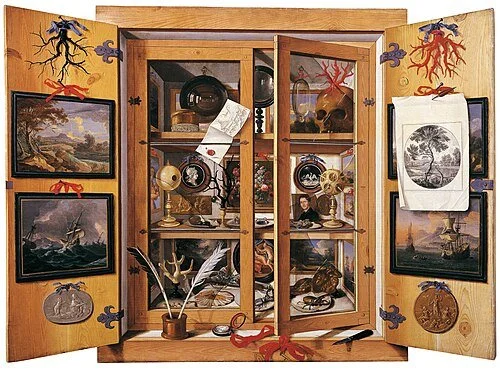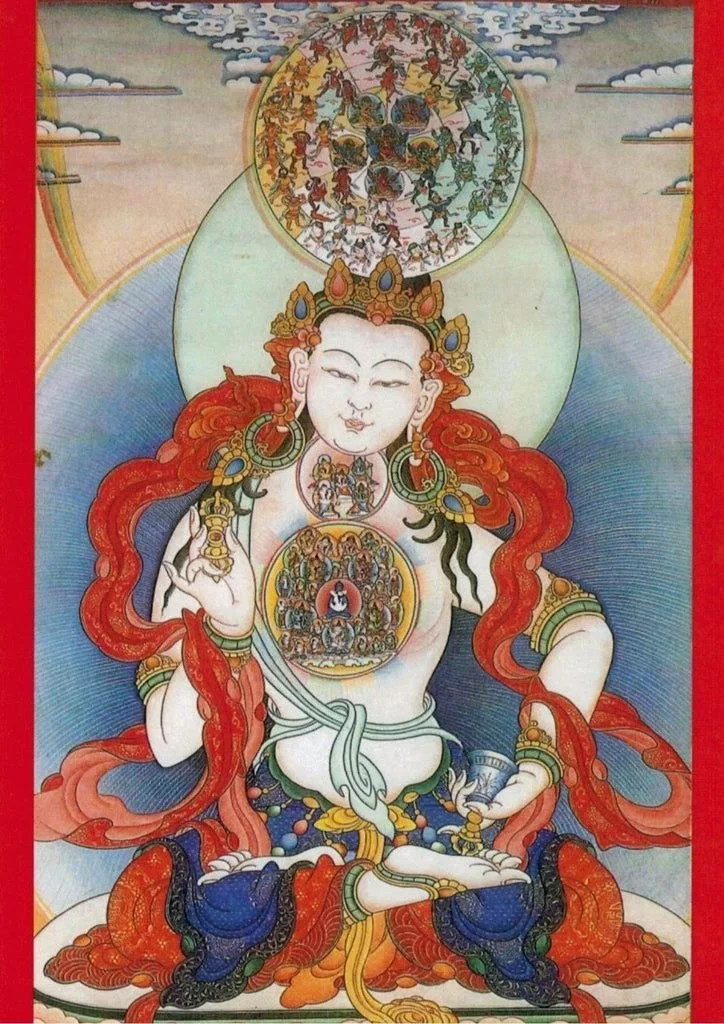The Curio Cabinet of Dharma, Spirituality, & Writing
This post originally appeared in Your Wild And Radiant Mind, November 2025.
In a very predictable elder millennial way, I sometimes get nostalgic about the old internet—the days when being online felt like walking into a messy but fascinating junk store filled with odd and shiny objects, like a life-sized cabinet of curiosities.
The internet, at its best, feels like looking into a wunderkammer, a cabinet of curiosities. Here’s one by Domenico Remps, 1690.
I miss the days of unexpected internet rabbit holes and Tumblrs and blogs. An internet that was curated by people and our multi-hyphenate interests, not AI or algorithms that want to smooth out our edges.
Maybe this isn’t just nostalgia or middle-age but the voice of my inner curator who likes to arrange a bunch of seemingly unconnected things on a shelf until a relationship between all of them appears and a new idea steps forward.
So this month, you’ll find curated lists of what I’ve loved on the internet and elsewhere lately. This includes:
A couple of very short pieces I’ve written and published outside of Substack.
A hodgepodge of recommendations on dharma and spirituality.
A collection of supportive resources and inspiration for writers
My nostalgia for the old internet also makes me miss websites. So I revamped mine and started a blog which will allow me to go a little more into the weeds about both dharma practice and life as a working writer. Intersections and convergences are my favorite place to hang out, but the pieces below both felt a bit too specialized to post in the newsletter so I published them on the blog.
“I Have A Blog Now” I’d recommend this post for any writer on Substack who has found themselves procrastinating on longer writing projects or more in-depth reading by trying to keep up with the 100 newsletters they impulsively subscribed to like a kid in a candy store.
“No Solitary Dharma Practitioners,” I’d recommend this one for anyone who has questions about how solitary dharma practice benefits others, and why practicing outside of group settings should not be considered selfish or isolated or self-help. I take a glimpse at how meditating in a cave for forty years can awaken both a person and the world.
The Curio Cabinet of Dharma & Spirituality
A friend sent me this recording of Yeye Luisah Teish, a Yoruba priestess, telling a story about Oshun, the goddess of love, sensuality, beauty, art, and fresh water. Early on in creation, one of the male gods convinced everyone that they didn’t need Oshun. Not to spoil the ending for you but it turns out no one is happy when the goddess of love is unhappy. If you need a reminder about why you should never exile the divine feminine, this story is for you.
I read and enjoyed an interview excerpt in Kosmos Journal between Alnoor Ladha, Martin Martin Winiecki, and Rhonda Fabian on sacred activism and grief, collapse, and mysticism. This led me to another conversation on non-dual activism in this conversation between Alnoor Ladha and Bayo Akomolafe on the Deschooling podcast and their thoughts on activism as dis-ability, non-dual activism, and whiteness as terraforming.
And then I found these tools for culture hacking which might come in useful to anyone finding their town or city under attack by ICE agents who are kidnapping immigrant teachers straight out of day cares in front of terrified children.
I recently discovered the work of Manchán Magan, a folklorist and Irish-Gaelic speaker who rescued Irish words from extinction in books such as Thirty-Two Words For Field. It sounds quirky and whimsical until you consider how language shapes our relationship to the more-than-human world and that within the age of post-colonialism and climate change, we’ve lost many of the words that help us not just describe nature, but see it.
Magan passed away last October of cancer and I very much appreciated this end-of-life interview with him, and look forward to also reading his book, Brehons and Brahams: Resonances between Irish and Indian cultures on the connection between ancient Celtic and Hindu culture (a mutual fascination with cows, a similarity between Kali and Cailleach, etc.).
I had a short convo with my friend the poet and writer Emily Mohn-Slate in the comments of last month’s post on spirituality and the more-than-human world.Here’s are thebooks I recommend on spiritual ecology in the comments. These books are in conversation with many of the themes of Braiding Sweetgrass, by Robin Wall Kimmerer, a Potawatomi biologist. I also also signed up for Plant Baby Plant, an initiative Robin Wall Kimmerer started to off-set the effects of climate change and habitat loss. I would also highly recommend the article, “Why The World Needs Spiritual Ecology” on Atmos.
I mowed my lawn reluctantly one last time for the season to grind the leaves because I was too busy to rake them. I ran over a bright green praying mantis who was just trying to take a nap, and I felt terrible about it, and then I read this article in The New York Times about how raking leaves is basically a massacre of tiny animals every fall and horrible for soil and ecological balance. So I will continue to annoy my neighbors by leaving some places in my yard wild and also not raking my leaves and I’m just going to have to learn not to feel awkward about it.
I’ve always loved Sufi poetry and it’s been amazing to hear and see it performed with English translation. (Apologies to anyone who is avoiding Meta—I swear this is worth a peek if you’re into poems about the beloved and wine and take-downs about academics being…academic.) The performances by Qawwal Nusrat Fateh Ali and Farid Ayaz bring forth another dimension to the words and also has led me to discover some new-to-me poet like Bulleh Shah and Muhammad Iqbal and also some lyrics like “this universe is for you but you are not bound by the universe.”
My heart teacher, Lama Justin von Bujdoss, was featured in an article in The New York Times for the dark retreat center he recently started in Massachusetts. It’s a funny, lighthearted article that also touches upon the power of dark retreat, and I’m happy and proud that my teacher’s work is getting this kind of exposure in the world.
I have the 100,000 Songs of Milarepa on my bed-stand and am halfway through it, so I bought The Life Story of Milarepa translated by Lobsang P. Lhalungpa. It’s heartbreaking and intense and I would highly recommend it to anyone who is maybe not so excited about going home for the holidays, because maybe your childhood home is in metaphorical or actual ruins and you may, like Milarepa, end up meditating upon the bones of your dead mother.
In that vein, I went to Ryan Rose Weaver (she/hers)’s grief support group last month and it was absolutely amazing to be in a supportive community of people, all grieving various losses.
Really vibed with this clip by Dzongsar Khyentse Rinpoche (“Your most vicious and final obstacle to awakening is Buddhism itself”) and this introduction to Dzogchen by Lema Lena (“Fuck your realization”).
Support and Inspiration for Writers
My sweetheart Juan Martinez has a fantastic interview on NPR about how he became a horror writer: he spent a year of his adolescence bed-ridden after being told that he only had a year to live. If you need a reminder that good writing comes out of restlessness and barely thwarted disasters, this one is for you. No one ever becomes a writer because they grew up in some kind of pristine environment where everything was safe and all their needs were met.
This piece by Ana-Sprouls Latimer, “The seven cognitive distortions behind every bad publishing take (and PS, you probably struggle with them too, and they might be destroying your career),” is one of the most sensible, honest, funny things I’ve read about being a working writer. She writes, “Just PLEASE believe me on this: your brittleness about rejection, your bitterness about it, subtracts far more from your overall career potential than any amount of writing talent could possibly add. Remember that. Remember that, and get over yourself as a matter of professional urgency.”
Save this one as a pep talk for when you’re about to throw your manuscript into the trash or dramatically burn it in the fireplace.
I’ve been reading Lauren Groff’s The Best American Short Stories 2024 and am appreciating how shaggy these stories are and how they don’t follow neat parabolas but swirly paths.
Last summer, I asked a friend at a poetry reading about what I could do to become a better poet.
I was hoping my friend would tell me the name of some how-to book that would magically compensate for years of neglecting to write poetry but it turns out that the secret to writing better poetry is, shockingly, through reading a lot of poetry, thinking about why you liked it, and then writing a lot of shitty poetry until it’s no longer shitty. Which is the exact the same process that taught me how write fiction but, to be honest, I thought poetry would be easier. I was mistaken.
So I’ve been reading a nature anthology, You Are Here: Poetry In The Natural Word, by Ada Limón and I reread Nine Gates by Jane Hirshfield, a book of poetry criticism that I love generally but still can’t get over the fascination of Wallace Steven’s “13 Ways of Looking at a Blackbird” and why this takes up a whole chapter in the book. (Sorry if that yacks your yum, serious poets).
Thank you!
Thank you times a hundred to all the people who donated to the Illinois Campaign for Immigrant and Refugee Rights last month by paying for a subscription to my newsletter. I was able to raise $150 in donations via paid subscriptions, all of which went directly to supporting immigrants in Chicago and Illinois. Amazing! Thank you for your generosity!
Vajrasattava with a curio cabinet in their heart.

